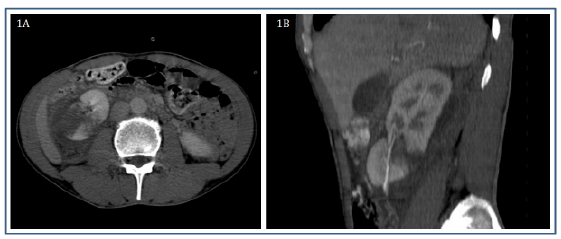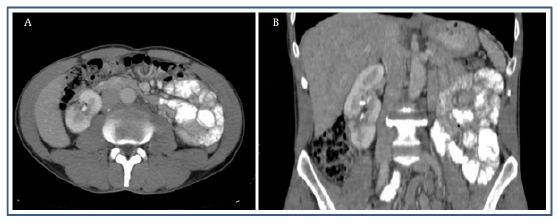
Figure 1: Tomography revealed full layer laceration in the right kidney inferior pole and a neighboring area of hematoma extending inferiorly - 1A: transverse plane and 1B: sagittal plane.

Eyup Burak Sancak*1 Mustafa Resorlu2 Alpaslan Akbas1 Murat Tolga Gulpinar1 Gurhan Adam2
1Department of Urology, Canakkale Onsekiz Mart University, Faculty of Medicine, Canakkale, Turkey*Corresponding author: Eyup Burak Sancak, MD, Canakkale Onsekiz Mart Universitesi, Terzioglu Yerleskesi, Barbaros Mh, 17100, Canakkale, Turkey, Tel/Fax: +90 5323782204/ +90 286 2180393; E-mail: eyupburaksancak@comu.edu.tr
Animal-related traumas are a significant medical problem due to their serious potential to cause morbidity and mortality. Animal husbandry is still a major source of revenue in developing countries which increases the scale of the problem. Although there is little data in the literature concerning urinary system traumas arising from animal attacks, we encountered no reports of isolated severe renal injury developing after bovine attack. This report describes a case of grade 5 renal laceration developing following bovine attack and healing with conservative observation. We then discuss the most favorable approach to urinary system traumas and grade 5 renal lacerations associated with animal attacks.
Bovine attack; Renal laceration; Conservative treatment
Despite the increasing urbanization of modern society and rapid contraction of natural, environmental spaces, trauma arising in association with animal attacks still represents a significant social and medical problem [1]. Traumas associated with dog, horse, cat, cow and pig attacks are commonly seen, and all animals can cause injury through different mechanisms [1]. These traumas, which may even be fatal, are seldom the subject of investigation, either worldwide or in Turkey.
Urinary system injury following abdominal trauma is observed at a level of approximately 10% [2]. The most common urological organ injured after trauma is the kidney [3]. Patients are generally monitored conservatively after renal trauma, although embolization or open surgery may sometimes be required with interventional radiology. Kidney trauma is classified from grade 1 to grade 5 on the basis of laceration and vascular injury defined by the American Association for the Surgery of Trauma (AAST). Studies in recent years have also regarded conservative management as an alternative among the treatment options for grade 5 parenchymal renal traumas [4,5]. The purpose of this report was to discuss animal trauma-related kidney injuries in terms of a grade 5 renal laceration associated with bovine attack and the place of conservative treatment for grade 5 renal laceration.
A 41-year-old male presented to the emergency department with trauma suffered approximately 8 h previously. The patient described an attack by a cow to the right flank area, and there was marked sensitivity in the flank region on physical examination. The patient had no rebound and defense and no additional pathology other than ecchymosis in the lumbar region was encountered. Vital values were blood pressure 140/90, pulse 84, and fever 36.3. Laboratory values were WBC 15.10 k/mL (4.5-10.7), Hb 13.4 g/dL (13.6-17.2), Hct 40.4 (39.5-50.3), Plt 200 k/mL (159- 388), BUN 32 mg/dL (0-50) and Cr 0.8 mg/dL (0.7-1.2). No pathology was determined on hemostasis tests (aPTT and PT-INR). Hematuria (577 erythrocyte/hpf) and pyuria (12 leukocyte/hpf) were detected on a urine test. Ultrasound evaluation revealed light expansion and heterogeneous appearance in the right inferior pole and retroperitoneal hematoma. Color Doppler ultrasound revealed markedly reduced vascularization in the right kidney inferior pole compared to other areas, and computed tomography (CT) angiography was planned. Tomography revealed full layer laceration in the right kidney inferior pole and a neighboring area of hematoma extending inferiorly (Figures 1A and 1B). No contrast extravasation was determined and vital findings were stable. The patient was placed under observation. Vital signs, intake and output and blood values were closely monitored. The patient had no additional problem and was discharged on the 5th day. Blood results, urine tests and vital signs were normal after the 6th week, while on tomography the retroperitoneal localized hematoma had shrunk but still persisted, there was no urinoma and the laceration line had begun to close (Figures 2A and 2B).

Figure 1: Tomography revealed full layer laceration in the right kidney inferior pole and a neighboring area of hematoma extending inferiorly - 1A: transverse plane and 1B: sagittal plane.

Figure 2: The retroperitoneal localized hematoma had shrunk but still persisted, there was no urinoma and the laceration line had begun to close 6 weeks after the trauma - 2A: transverse plane and 2B: frontal plane.
Thousands of injuries and hundreds of deaths due to trauma resulting from animal attacks occur every year [6,7]. With traumas caused by large animals, such as cattle, there is a high transfer of energy, similar to that in motor vehicle injuries [8]. Murphy et al. [9] investigated traumas caused by cows alone and reported their 10-year experience in a single center. The main source of trauma caused by cows was kicks, with head butts, body contact and bites being much rarer. The most common forms of injury were bone fractures, followed by soft tissue injuries. Abdominal organ injury was determined in only one of the 47 patients in the series.
The species of animal causing trauma, and the type of trauma, varies according to Turkey’s geographical characteristics. Emet et al. [10] evaluated trauma associated with 921 animals over a 2-year period; 29.9% were caused by dogs, 21.7% by horses, 12.3% by farm animals, 9.1% by bees, 8.1% by scorpions and 18.9% by other species (snakes, cats, ticks, rats, donkeys, wolves, bears and birds). Yıldız and Durukan [11] reported that 57.9% of injuries were caused by horses, 21.1% by cattle, 15.8% by donkeys and 5.3% by cats.
Trauma is one of the main causes of morbidity and mortality throughout the world [12,13]. Kidney trauma is seen in 8-10% of all blunt and penetrating abdominal injuries [2]. The basic imaging technique used when intra-abdominal organ injury is suspected following trauma is computerized tomography (CT) [14,15]. Contrast CT is required for kidney trauma due to the need to image renal hemorrhage and the collecting system [12,16]. Higher grades indicate increasing severity of renal injury. Grade 5 renal trauma is defined as shattered kidney or renal pedicle injury [5]. Definitive surgical exploration of grade 5 blunt renal trauma is recommended in the guidelines, although publications in recent years have suggested that hemodynamically stable patients can be monitored conservatively [5,17].
Aragona et al. [18] shared their 10-year experience of severe blunt renal trauma, reporting 21 cases of grade 3 renal traumas among a total of 221 renal trauma cases, 18 grade 4 cases and 6 grade 5 cases. Nephrectomy levels were 9% for grade 3, 22% for grade 4 and 83% for grade 5. This high level of nephrectomy shows how important it is to decide on the approach to grade 5 renal traumas. Surgical procedure must be performed on patients who are not hemodynamically stable despite crystalloid and blood product replacement therapy and with expanding retroperitoneal hematoma and hemorrhage [5].
Kidney repair or partial nephrectomy may be the most appropriate surgical procedure for major polar kidney injuries or midline lacerations. In anemic, constantly tachycardic patients with flank pain, repeated low dose tomographies may be needed to identify hemorrhage associated with arteriovenous fistula formation or pseudoaneurysm. Renal angiography may be performed with stable renal patients of grade 3 or above. Transcatheter embolization may be performed at this point if active hemorrhage is identified [2].
Trauma associated with large animals in particular may lead to severe organ injuries, as in our case. Assessment and management of such patients is similar to that of general trauma patients. Conservative treatment based on close observation should be considered as the first treatment option for hemodynamically stable patients with grade 5 renal lacerations. If major vessel injury is suspected on tomography in the arterial phase, surgical intervention must be considered. Repeated tomography imaging may be useful in showing persisting or delayed hemorrhages. Super selective arterial embolization is the best option in recurring hemorrhages associated with pseudoaneurysm or arteriovenous fistula. Conservative observation accompanied by close renal observation in order to protect parenchymal functions and minimize morbidity is an increasingly popular approach and one needing to be borne in mind once survival has been guaranteed in patients presenting with renal trauma.
The authors declare no conflict of interest.
Download Provisional PDF Here
Article Type: Research Article
Citation: Sancak EB, Resorlu M, Akbas A, Gulpinar MT, Adam G (2016) Allograft Nephrectomy for Malignancy: Report of Seven Cases and Review of the Literature. Int J Nephrol Kidney Failure 2(2): doi http:// dx.doi.org/10.16966/2380-5498.127
Copyright: © 2016 Sancak EB, et al. This is an open-access article distributed under the terms of the Creative Commons Attribution License, which permits unrestricted use, distribution, and reproduction in any medium, provided the original author and source are credited.
Publication history:
All Sci Forschen Journals are Open Access